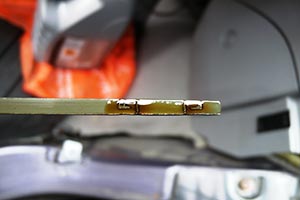Report Finds New Oil Blends Could Improve Fuel Efficiency Up to 1.5%

Two new low-viscosity oil lubricants set to come onto the market, CK-4 and FA-4, will improve fuel efficiency in heavy-duty trucks between 0.5% and 1.5%, according to a new report from the North American Council for Freight Efficiency.
The report recommends carriers with Class 8 fleets switch their oil from a 15W-40 heavy-duty blend to the new CK-4 variant of the lighter 5W/10W-30 when it becomes available at the end of the year. Eventually NACFE would like to see carriers switch to FA-4 variant with 2017 diesel engines, which could add another 0.4% to 0.7% in fuel savings. Both new variants emerged from what was first known as Proposed Category 11 or PC-11.
NACFE recommends fleet owners use a conservative 0.5% estimate when calculating the return-on-investment and making a final decision. Executive director Mike Roeth told reporters on a conference call that about 20% of trucks in the industry are planning to adopt these new oils.
RELATED: New Engine Oils Coming in December
“What we found in the report leads us to believe that more fleets should consider it. It saves some fuel and there is a business case for it,” he said.
The new CK-4 class, replacing the 10-year-old CJ-4, and the FA-4 class will improve oxidation stability, aeration control, shear stability and adhesive wear control — meaning they resist thickening and will be less likely to foam or break apart while lubricating hot-running diesel engines. The new oil classes will also be more compatible with bio-diesel blends.
“There is much more to what makes an oil work than its base viscosity,” said Yunsu Park, NACFE study manager. “But we’ve actually had one manufacturer tell us that, after analysis, the low viscosity oil actually showed less wear when you take all the components apart.”
The biggest concern from the trucking industry has been the issue of backward compatibility because fleet owners don’t want to have two oils in their system, NACFE said. CK-4 will be work with existing engines that use CJ-4, but it is unclear whether FA-4 will be backwards compatible.
“We challenge the engine OEMs to approve the new oils for backwards compatibility to older engines, where it makes sense, as far back as possible,” Roeth said. “When I went into this, I was under the assumption the FA-4 would not be backward compatible. I was thinking it would take a long time for this oil. It is not approved to be backwards compatible, but as they start testing old engines with the new oil, maybe it will.”
The new category of oils is intended to satisfy the second step in Phase 1 of the federal greenhouse-gas emissions rules, which require manufacturers to reduce carbon dioxide emissions 3% in January 2017 from January 2014 levels. The Environmental Protection Agency and the National Highway Traffic Safety Administration are expected to propose a second phase of rules on greenhouse-gas emissions and fuel-efficiency standards for medium- and heavy-duty trucks after an ongoing review from the Office of Management and Budget is complete. A 2007 report found that freight trucking is responsible for 1.6 gigatons of carbon dioxide emissions per year — approximately 5.75% of total worldwide greenhouse-gas emissions.




